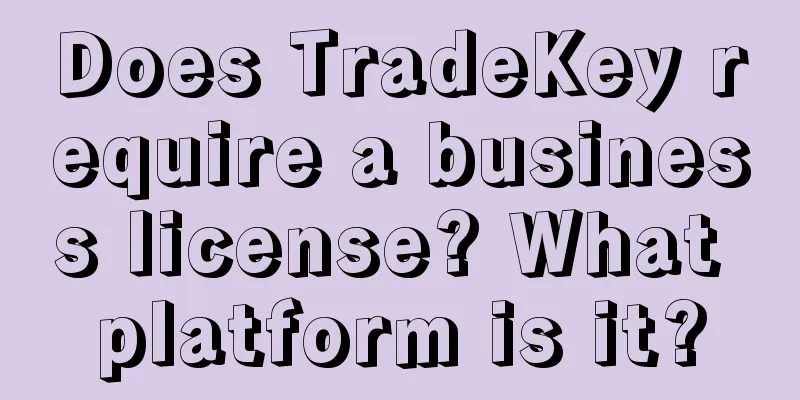From familiarity to proficiency, how to take over a project halfway?

haven't seen you for a long time! A while ago, I had a chat room, and there was a topic: How can we make a smooth transition and start a new business? There are very few descriptions of this topic on the market, and most of them are presented in an ideal situation, which is equivalent to saying that all the conditions are met and you just need to execute according to the logic. The reality is that it is rare to start completely from 0 to 1. More often than not, a business is taken over halfway. For example: joining a new company, it is normal to find that the company you worked for previously tried but failed to succeed in doing the business, or you have to clean up the mess for your predecessor in that business. Therefore, the entry point of today's article is how to take over a half-finished project. I will try my best to sort it out systematically from the perspective of a trader, and I hope it will be of some reference to everyone. 1. Communicate business background and demandsThe first time we learn about business information, we usually do homework before the interview or get it during the interview. It is obviously not enough to fully understand a business with just this information. Therefore, after entering the company, we need to understand the business background and demands. I think we need to understand at least the following aspects: 1. Business BackgroundSituation 1: Some bosses will say: "I have a friend who is good at xxx." Situation 2: We have relevant resources and advantages, and have absolute confidence that we can do it. Situation three: If xxx has been done, and we don’t do it, we will not be able to face competition from competing products in the future. Situation 4: We do xxx because we want to achieve xxx goal, which is a key link. No matter which of the four situations, we must follow the boss's instructions and continue to dig deep into key information to find the key points for decision-making. Don’t easily deny the value of doing this business, otherwise in most cases you will lose the meaning of your existence (there will be no reason to hire you). For the four situations mentioned above, you need to have basic ideas: For case one: Find out who your boss is interested in and work hard to build connections. If the boss can be persuaded by his friend, then it means there exists a set of persuasive logic and key information clues that can impress the boss. For case 2: Sort out the advantages and disadvantages of doing this business in a timely manner, and compile a list of relevant resources. Only when you have the ammunition can you strike point by point. For situation three: Pay attention to competitor trends in a timely manner. In addition to following competitors, you should also develop differentiated competition strategies. For situation 4: Communicate and confirm with your boss regularly and frequently to ensure that your two minds are on the same page. Next, let’s talk about business goals. Here is a situation that everyone needs to pay attention to: Many times the boss only has a vague goal or even no goal, which cannot be made clear in a simple communication. At this time, we don’t have to worry about whether the goal must meet the 5w2h standard, but it will gradually become clear in the process of continuous verification and confirmation. What needs to be understood is that in this situation, communication upwards must be done well and at a certain frequency. If clear conclusions are brought forward each time you communicate, the goal will gradually become clear. In the first few communications, we don’t rush to get a numerical target, but instead understand the purpose first. Finally, you can set the target and communicate and confirm it with your boss. In view of the different stages of business development, the boss usually focuses on different things. There are generally two situations: The first situation: when starting a business What we often hear in this situation is: "Don't worry about the income, just do it." Generally, the focus will be on traffic-related data and single/multiple activity revenues, rather than how complete the system you have built is. At this time, quickly gaining incremental growth is the focus of business operations management, whether in terms of traffic data or revenue. A more vivid way to put it is single-point combat, which brings incremental results through some gameplay and tests tactical ability. The second situation: when the business is formed You need a model that can be stably expanded to achieve greater goals. At this stage, all KPIs will be more refined, and there will be various indicators, such as labor efficiency, customer acquisition cost, ROI, etc. What is tested is your ability to manage a system. Compared to the original early stage, the focus of this stage is that you need to extract the underlying logic from the many gameplays, design a long-term effective growth mechanism, and regularly evaluate and iterate, which tests your strategic capabilities. Then we need to discuss goals with our boss based on the actual situation. At this time, we need to figure out what our current focus should be. 2. Current progressThe essence of this part is that we need to take stock of the current situation, including business progress, the status of team management, and the organization of resource conditions. (1) Development trajectory Due to the replacement of team leaders and changes in team members, there will be a gap in the business connection links, and the business historical data will be missing and scattered. At this time, we need to sort it out according to the timeline. Only after we understand the ins and outs can we get a better start. The business will have different focuses in different stages of development, so it is very necessary to understand what the "predecessors" mainly did and what results they produced, because this represents the change process of the core KPI. You will know what they did was effective, what was ineffective, and whether any valuable experience was retained. If it involves various daily weekly and monthly reports, you can get a glimpse into your communication habits with some colleagues, which will reduce obstacles for your future collaboration with other colleagues. In addition to the above content, there are also review materials, some currently used sops, etc. These need to be adjusted according to your goals after you get started. (2) Team status The first thing we need to do in terms of team is to build a contact list. After you sort out your business, you will know your collaborative relationships and scope of collaboration. After establishing a communication mechanism, you will be able to integrate into the team faster. For example: When dealing with the design department, you need to know some design common sense, and when communicating with the product manager, you need to understand what PRD, MRD, BRD, etc. are. Here I will just briefly talk about the precautions for cross-departmental communication. So how do you know which aspects to start with for your team? You can start with simple topics like region, interests, and food to build closer relationships, but ultimately the purpose of our communication should be to gain understanding of the business, awareness of goals, current work capabilities and attitudes, as well as understanding their expectations for their own growth, etc. After we have established a preliminary understanding, we need to divide the team members, gradually train them through tasks, and finally build a talent echelon for our own team. (3) Resource organization Regarding resources, they generally include customer resources, supplier resources, site resources, channel resources, etc. In the company I used to work for, there was a resources department. Needless to say, this department is very important. Its main responsibility is to maintain and expand resources. 3. Basic logic of prioritizationEverything is important, but there are still priorities. The first is phased goal management. What cannot be avoided is to obtain current business results. Of course, it is also very important to understand and organize business information as mentioned above, which will facilitate us to carry out our work better in the future. But this is a long-term job and does not need to be completed in one time. Therefore, we can break this part down into daily life, such as weekly meetings and daily communications. 2. Understand and sort out related businessesWhen sorting out the business, many people's first reaction to this problem is to look at the data, because data is the most direct reflection of the business situation. But data is based on business models. If there are problems with the business operating logic itself, then the data only reflects the results of the wrong model. The first step to understanding a business is to sort out the business model. There are four major links that make up a business: The production link, delivery link, market and transaction link, as well as the support and guarantee link. There are two things that operations managers need to do:
To sum up: increase revenue and reduce expenditure, reduce costs and increase efficiency, and be responsible for revenue. To sort out the business, we need to do the following three things: sort out business logic, formulate an operation framework, and establish an operation system. 1. Sort out business logicThe following figure is the organizational structure of an e-commerce company: The typical characteristics of e-commerce business are online operation + offline delivery . Online part: In addition to operation and promotion, there are also many other links such as product selection, pricing, listing, pre-sales and after-sales. Offline part: Including production, transportation, warehousing, logistics distribution, etc. After understanding these links, we will sort out the corresponding business processes, and the final results are as follows: Here we can see that to generate a profit, there are at least 11 nodes that can be managed and optimized. 2. Develop an operational frameworkBased on the four major business aspects mentioned above and combined with the organizational structure, we can come up with a basically applicable operating framework. The operation of a business usually involves multiple departments. Quickly figuring out your collaborative relationships and confirming the communication mechanism in advance will save you a lot of trouble when taking over the business. Generally speaking, the first-level departments will not change much, but the departments at lower levels will make adjustments as the development stage and growth strategies change. For example, live broadcast operations and private domain operations, which have been popular in the past two years, are generally established as sub-departments of the e-commerce operations department in the early stage. As the scale of development increases, they may also become a larger department and exist independently. Of course, if new platforms and new tools are produced in the future, they may also complete their historical mission and face adjustments or dissolution. Of course, as the company's business develops, this operating framework will gradually change and become more and more detailed. For example, there will be a second-level department, or even a third-level, fourth-level department... At this time, levels will appear, and the complexity of management will increase. After sorting out these, we further sort out and optimize according to the development stage and goal requirements. Here, the business leader needs to understand that our task is to fill the gap between the current status quo and future goals and find an operating system that supports us to achieve our goals. 3. Build an operation systemAfter sorting out the business logic, operation framework, and business value, the next step is to build the operation system. So what is an operating system? The operation system is designed to achieve business goals, and it is a series of rules, methods, and resources accumulated through long-term operations, which are equivalent to the strategy and cheats for playing a game. The operating system is generally composed of five elements, as follows:
Take the global operation mentioned by Tencent Advertising as an example The biggest business handle is the formula derived from GMV. By breaking it down layer by layer, we can get more detailed handles. Each handle is composed of multiple links, and so on. Due to the length of the article, I will not introduce the following content in detail. Just understand the idea. When organizing the operation handles, we need to pay attention to the following points: (1) Determine the input and output of the operating system and have clear goals. The goals here need to be clear. Goals must have a starting point and an end point, and there must be a time limit. Just saying a number is not a quantitative goal. Instead, a clear goal is to reach a certain state from a certain state. (2) Determine the starting point for intervention in the operational process. Generally speaking, the node with the greatest global impact is followed, followed by the node with the largest leakage, and finally the factor with the least resource investment. (3) Sort out the channels or paths from input to output, what the process is, what resources to invest, what standards to achieve, and what the key steps are. (Prioritize quantitative and data-based areas) (4) Assembling a complete operating formula 3. Manage and optimize business1. Check for deficiencies and fill in the gapsWe have already sorted out the business logic, operation framework and operation system. However, after sorting out, you will find that some paths are not smooth or some key links are missing, so we need to screen them out and fill in the gaps in time. I have observed this situation in the companies I have contacted before: many companies hope to bring in a lot of new growth through a certain gameplay, but in fact the most basic "infrastructure" is missing or incomplete. In this case, even if you want to rely on hot-selling activities to bring in new volume, it will be difficult to start due to insufficient basic traffic. Even if you have a hot-selling activity, it will cause a large amount of traffic loss due to the lack of links, making it even more difficult to achieve growth. Only by ensuring a stable supply of daily traffic and using systematic growth measures to increase overall potential can we achieve larger-scale growth. So how to start is the next question we face. Here we need to sort out the necessary conditions to promote users to complete core behaviors. There are at least two directions:
Combined with the business logic we sorted out earlier, we can further organize it: Content section:
Functional part:
Then what we need to do is to match the corresponding strategies and methods in these links. Improve the user's value experience at each point. Of course, in addition to these, we also need corresponding strategies to guide users, such as first order, repeat purchase, distribution, points, membership, etc., which will not be expanded here. 2. Notes(1) Even if we know the problems in business operations, we should not rush to make drastic reforms. Instead, we should formulate a short-, medium-, and long-term business plan (which must be aligned with the goals) and make adjustments step by step. (2) When you first take over a business, you should distinguish between combat objectives and strategic objectives. For example, if you are responsible for some temporary activities (which also need to achieve results) soon after joining the company, this is a combat type, but more importantly, it is a strategic type to achieve phased results based on the plan you and your boss jointly develop. Don't lose sight of one while focusing on the other. But we still need to cultivate our ability to achieve results quickly. (3) For smaller companies, hit events are more important than basic traffic, because most do not have strong traffic management capabilities, and they must first get money before discussing other matters. Subsequent traffic management capabilities will not be a rigid demand in the short term. For larger companies, the basic traffic is greater than the operation of hot-selling activities, which requires you to make system-level improvements. The operational capabilities required in these two environments are different. The former requires you to have stronger execution ability, while the latter requires you to have more business thinking. The above is today's sharing content, which may be boring to read and a bit theoretical. There are still many shortcomings, but as the subsequent thinking is improved, I will further sort it out. Author: Zhizhong WeChat public account: Shixian Operation (ID: yyshixian) |
<<: If you copy the benchmark account well, you will make money.
Recommend
How long does it usually take for Amazon to withdraw cash? What are the withdrawal rules?
Now the prospect of cross-border e-commerce is rea...
What is Shopee commission? What are the commission standards?
The operation of each Shopee site is different, an...
The new proposition of Cat and Dog Fighting: from sinking market to sinking demand
In today's consumer market, the concept of &qu...
Inventory of popular live broadcast rooms in 2022: some remain popular, while others disappear
This article reviews the popular live broadcast ro...
How does KFC's Crazy Thursday continue to be so popular?
This article specifically analyzes the reasons why...
This year's Double Eleven, we also began to pay attention to "his marketing"
During this year's Double 11 Shopping Festival...
Brand dividend
This article mainly analyzes the eleven elements o...
2022 Annual Review (I): The underlying logic of good products, good growth, and good sales
2022 has passed. Looking back on this year, many n...
Can Wish still be done in 2021? Why?
The cross-border e-commerce industry is developing...
Xiaohongshu's autumn promotion incentives are online, come and share the traffic
Xiaohongshu's autumn promotion incentives are ...
Will the content still be there after deleting the Facebook account? How to delete the Facebook account?
Some users may consider deleting their Facebook ac...
How many levels are there for Shopee's deductions? Will the deductions be reset?
There is a saying that goes, there is no order wit...
What is the difference between Amazon local stores and cross-border stores?
To open a store on Amazon, you first need to choos...
Can I open a Shopee account with a studio's business license? How can I register?
We all know that if you want to open a store and s...
How to increase cross-border e-commerce sales? How to increase sales?
The first step for a novice to engage in cross-bor...









